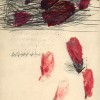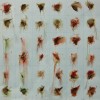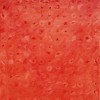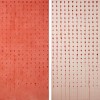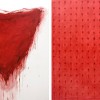2005-2008
- Untitled, From “Les Fleurs Du Mal” series, 2005, Oil & Pencil on Card bord, 30×20 cm
- Untitled, From “Les Fleurs Du Mal” series, 2005, Oil & Pencil on Card board, 30×20 cm
- Untitled, From “Les Fleurs Du Mal” series, 2005, Oil & Pencil on Card board, 30×20 cm
- Untitled, From “Les Fleurs Du Mal” series, 2006, Oil & Pencil on Card board, 30×20 cm
- Untitled, From “Les Fleurs Du Mal” series, 2006, Oil & Pencil on Card board, 30×20 cm
- Untitled, From “Les Fleurs Du Mal” series, 2007, Oil & Pencil on Canvas, 60×80 cm
- Untitled, From “Les Fleurs Du Mal” series, 2007, Oil & Pencil on Canvas, 100×120 cm
- Untitled, From “Les Fleurs Du Mal” series, 2007, Oil & Pencil on Canvas, Diptych, 140×100 cm
- Untitled, From “Les Fleurs Du Mal” series, 2007, Oil & Pencil on Canvas, 180×130 cm
- Untitled, From “Les Fleurs Du Mal” series, 2008, Oil & Pencil on Canvas, Diptych 250×360 cm
- Untitled, From “Les Fleurs Du Mal” series, 2008, Oil & Pencil on Canvas, Diptych 210×360 cm
The Eroticism of Decay
The morbid poetry of the 19th century plays an essential role in the work of the Iranian artist Azadeh Razaghdoost: the poem ”The Sick Rose“ (1794) by the Romantic poet William Blake and the volume of poetry” Les fleurs du mal“ (1857) by Charles Baudelaire have inspired series of work over several years, dominated by the expressive use of red.
Both literary works have the dark side of human nature as a common treatment and therefore find a sensual and allegorical language. Thus Blake’s line, ”thy bed of crimson joy,“ is not only a sensual metaphor but also distinguishes the character of Azadeh Razaghdoost’s works: the ostensible attractiveness of palettes and motives refer further to the basic drives of human existence.
The trickling and smeared blood-red paint initially gives us a violent impression of a vigorously spattered life. At the same time, the colour radiates an unrestrained eroticism, which culminates in glowing heart shapes or pubic triangles before a pure white background. In the works, there is a conflict in Freud’s contrast principles of ”Eros“ and ”Thanatos“, life and death drives collide and grapple with each other in a visually enthralling, however, also very tenderly drawn way. At times, both principles seem to be so closely knitted together that the contrasting desire and decay become a single entity.
This topic is intensified in the symbol of flowers, protagonists in both titles of the poems, which unify as an ultimative vanitas motif of blossom and transience. Fragile, isolated, stemless blossom heads, arrange themselves next to each other and, at the same time, seem to radiate and exsanguinate. We are not dealing with healthy plants, they are contaminated with sickness and evil, the powerful red is discolored with brown and grey tones, yet, this is exactly from where the blossoms draw their supernatural shine.
In more recent works, there is a transition from the large formatted and heavy picture bodies to a serial order of smaller parts. A diptych juxtaposes both forms: a massive calyx impacts a meticulous alignment of small calyxes, which gradually lose color and luminance like a collection of impaled, faded butterflies. In other works, the blossoms fray in wing-shaped forms spread loosely across the painting. The artist knows just how to weight her canvas in an accomplished and poetic way, when it comes to volume.
On closer observation of the works, the brush strokes seem to be like garlands dancing in dynamic arcs and strokes across the canvas. The forms are seldomly defined but are much more surmisable. Even in the methods of work, the way in which the interlocking and fleetingness conjugate becomes increasingly apparent.
The continuing leitmotif of lightness and weight, life and death, eroticism and mortality, the energy of these elementary polarities ignite the work of Azadeh Razaghdoost, lifts the rather conventional subject of motifs far beyond being a decorative function and makes it become a shimmering metaphor.
Julia Häcki, Zurich
April 2009




